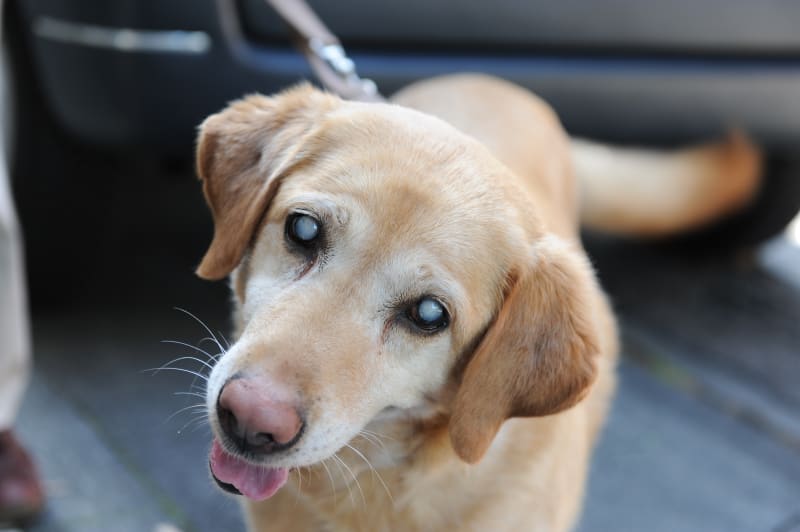
Have you seen that your dog’s eyes seem to be cloudy? You may have noticed that your dog is always bumping into things. Cataracts, a condition that causes the eye lens to become cloudy and may lead to visual issues, manifest in a variety of ways in dogs.
Maintaining good eye health for your dog is crucial to ensuring its safety and happiness in the world. If you think your dog has cataracts, what can you do to aid them? Learn about the signs of canine cataracts, what causes them, how to treat them, and how to avoid them with this detailed resource. Learn more about cataracts in dogs by reading this text from beginning to end, or by following the many links provided.
The Term “Cataract” Mean?
Cataracts are a common kind of vision loss caused by a clouding of the lens, which blocks light from reaching the retina. The retina is a thin layer of tissue along the back of the eye that transmits light impulses to the brain, which are then interpreted as visual pictures. An impaired dog’s vision or complete blindness might result from damage to the retina.
Although it’s frightening to think of your animal friend becoming blind, eyesight loss occurs slowly over time. A cataract may be treated, but unfortunately, its progression cannot be slowed. To prevent additional loss of vision, cataracts should be treated as soon as possible.
Symptoms
Exactly how can canine cataracts manifest themselves? A foggy look with a white, gray, or blue hue is one of the unmistakable indicators of a cataract. This cloudiness may obscure either one or both eyes, as well as a localized region of the lens or the whole structure. Cataracts are the most common cause of cloudy eyes in dogs, but older dogs may also develop a disorder called nuclear or lenticular sclerosis, which has similar symptoms but does not cause pain or blindness.
Additional symptoms of canine cataracts include:
- Difficulty navigating in bright light
- Excessive blinking
- Bumping into furniture
- Changes in behavior
- Hesitation when moving
- Inflammation of eye
Keep in mind that when cataracts first begin to develop, it may be challenging for pet parents to recognize the symptoms since dogs can use their powerful noses and ears to compensate for vision loss. Still, it’s essential to know the signs because secondary complications can occur as the cataract matures, such as:
- Inflammation in the eye (anterior uveitis – Cataracts and anterior uveitis are common causes of irreversible vision loss. Trauma and other disorders can cause blood vessels to rupture, leading to inflammation.
- Glaucoma – The optic nerve may be damaged by glaucoma, a condition that causes fluid to build up in the eye. The iridocorneal angle, responsible for maintaining adequate fluid levels in the eye, may become inflamed and damaged due to cataracts. In the event of injury to the optic nerve, visual loss may result.
Causes
There are many factors that cause cataracts in dogs to develop, including:
- Genetics
- Age
- Malnutrition
- Radiation
- Inflammation
- Trauma
- Diabetes
Depending on the root of your dog’s cataracts, it may not mature or cause blindness. This is why it’s important to identify if an underlying condition is to blame. Effectively treating and managing health conditions can hinder the growth of a cataract.
Cataracts and Diabetes
Cataracts in dogs are often brought on by diabetes. In fact, 16 months after being diagnosed, 80% of diabetic dogs will have cataracts. Because of this, diabetic dogs are more likely to develop eye problems and eventually become blind. Diabetes-related cataracts develop when the sugar from the blood enters the lens of the eye, giving it a foggy look.
Genetics
Another common cause of cataracts is genetics. Unfortunately, some dog breeds are more susceptible to canine cataracts, such as:
- Australian Shepherd
- Bichon Frise
- Boston Terrier
- French Bulldog
- American Staffordshire Terrier
- Havanese
- Silky Terrier
- Miniature Schnauzer
- Poodle
- Cocker Spaniel
- Labrador Retriever
- Siberian Husky
- West Highland Terrier
Though certain dog breeds and pooches with preexisting illnesses are more likely to acquire diabetes, any dog is at risk for having the disease. Regardless of the breed or health status of your dog, you should always be on the lookout for potential dangers. Make an appointment with your vet immediately if you see any changes in your dog’s eye color, shape, or behavior.
Diagnosis
The first step in diagnosing cataracts in dogs is a visit to the veterinarian. A vet will use a bright light and a magnifying lens to take a close look at your dog’s eyes. Even if a cataract isn’t apparent to the naked eye, they will be able to detect it. Keep in mind that cataracts are sluggish to grow, so catching them early can improve your pet’s prognosis.
Laboratory testing and other diagnostic procedures like an ocular ultrasound or electroretinography (ERG) may be recommended by your doctor to help discover the cause of your dog’s cataracts. Prevention of cataracts requires prompt treatment of the underlying diseases that cause them. A veterinarian will be able to tell you for sure whether your dog has cataracts or if it has nuclear sclerosis or another eye illness that mimics cataracts.
Treatment

Your dog’s cataracts need to be managed and prevented from becoming worse via the provision of the necessary therapy. It is possible to slow the progression of cataracts with the help of anti-inflammatory eye drops and lubricants, both of which may be obtained from a veterinarian. Remember that these remedies won’t undo the damage already done by the sickness. Surgery is the only option to remove the cataract and restore your dog’s eyesight.
For this surgical operation, your dog will be put to sleep with an anesthetic to ensure it’s as painless as possible for them. The cataract in the damaged eye will then be surgically removed by a veterinarian. When your dog has recovered enough from surgery, the vet will send you home with post-op instructions for caring for your dog’s eyes. In extreme cases, an Elizabethan collar may be necessary to prevent your dog from scratching or touching its eyes. Eye drops to combat dryness and irritation, reduce the risk of infection, and promote healing may also be recommended.
Rapid treatment of canine cataracts is necessary to preserve your dog’s eyesight. Cataracts, if unchecked, may lead to irreversible vision loss and even more serious conditions like glaucoma or anterior uveitis. Cataract removal surgery might temporarily trigger inflammation, making it unsafe for dogs with glaucoma or ocular irritation. In fact, it may make your dog’s eyesight worse.
Prevention
Unfortunately, there’s no foolproof way to prevent canine cataracts, especially if the cause is old age. But, there are several steps you can take to identify issues early on and reduce the likelihood of permanent blindness from cataracts. This includes:
- Check your dog’s eyes regularly for noticeable warning signs of cataracts.
- Scheduling routine checkups with your veterinarian, specifically if they’re more at risk for developing the disease due to genetics or an underlying condition.
- Take your dog to the vet as soon as you notice changes in the appearance of your dog’s eyes or behavior.
- Discussing available treatment options with your veterinarian to manage health ailments that cause cataracts.
- Watching out for eye injuries and trauma and making sure to treat them right away.
Questions
Cataracts are distressing for you and your dog, whether they develop gradually as your pet ages or suddenly take on an opaque look on the lens of its eye. Below are solutions to some of the most often asked problems about canine cataracts.
Do cataracts in dogs cause discomfort?
Cataracts in dogs aren’t lethal, but they may negatively impact their quality of life. These obstructions might make it more challenging for your animal buddy to recognize your arrival home from work or your confident navigation of familiar territory. Cataracts may also lead to glaucoma and anterior uveitis and other complications.
Do cataracts in dogs cause any pain?
Cataracts often cause little discomfort on their own. However, discomfort and suffering might be caused by secondary disorders related to cataracts, such as glaucoma or inflammation.
Can dogs with cataracts avoid surgery?
Treatments that don’t involve surgery may delay the development of cataracts in canines. But it won’t undo the damage or give your dog’s sight back. Cataracts can only be removed surgically. Once the cataract progresses to glaucoma, however, your dog will no longer be a candidate for surgery. For this reason, it is crucial to have regular wellness exams with your veterinarian, which should always include an assessment of the eyes and general health.
In Conclusion
Cataracts in a dog’s eye may be frightening, but they are usually treatable and won’t always lead to the dog’s death. When you follow the advice of your dog’s veterinarian, your pet can live a long, healthy life.